Algeria, Africa’s largest nation, offers an unexpected adventure beyond the usual tourist hotspots. This is a land of fascinating contrasts. It beckons the adventurous traveler with its rich history, breathtaking landscapes, and vibrant culture.
This journey takes us beyond the stereotypical images of vast deserts, delving into the heart of a country where Roman ruins remind us of a bygone era, Berber villages cling to rugged mountainsides, and the Sahara Desert unfolds in all its awe-inspiring majesty.
Algeria is so rich in beauty and resources that when the French colonized it in the 19th century, they made it a full-fledged province, just like Paris or Provence. This wasn’t just any colony! Algeria was once a major wine producer which also takes immense pride in its delicious cuisine (especially couscous!), and boasts a vibrant music scene.
So, why haven’t we all heard more about it? Perhaps the shadow of the Algerian Civil War (1992-2002) lingers, or maybe it’s because Algeria’s wealth comes from oil and gas, not tourism. This lack of mass tourism is precisely what makes Algeria intriguing for adventurous travelers. The good news is, getting a visa is now much easier thanks to the new visa on arrival system!
Map of Must Visit Places in Algeria
Traveling within Algeria is actually quite easy and inexpensive. Our flights between major hubs within the country were between $30 – $70 USD. However, the biggest question here is how many days can you spend in this huge country?! There are so many amazing places to visit that your itinerary will only be limited by the amount of time that you have.
Djanet and the Red Tadrart: A Saharan Escape
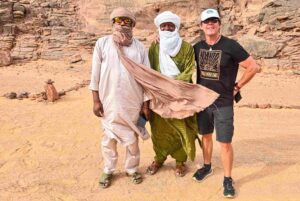
Our adventure began in Djanet, a charming town on the edge of the Sahara Desert that serves as the jumping off point for the many National Parks that are around it. Nicknamed the “Gateway to the Tassili,” Djanet was our launchpad for a 6-day camping expedition into the heart of the Red Tadrart. This awe-inspiring landscape, characterized by dramatic sandstone formations sculpted by wind and time, is a feast for the senses. Imagine towering red dunes reaching towards a limitless sky, punctuated by hidden canyons and prehistoric cave paintings.
Days are spent exploring this surreal landscape, either on invigorating hikes or heart pounding desert/dune drives. Keep your eyes peeled for the unique flora and fauna that have adapted to this harsh environment, including elusive fennec foxes and delicate desert flowers. As night falls, gather around a crackling campfire and be mesmerized by a canopy of stars unlike any you’ve ever witnessed.
Our guide and driver made our experience here pure magic! Each day we drove to a new set of magnificent sandstone formations, ancient cave paintings and jaw dropping sunsets from perfectly formed dunes reaching higher and higher into the sky. Our gourmet meals were made fresh and were in themselves a special occasion followed by the festive Touareg tea ceremony.
In Djanet, we recommend staying in La Grotte des Ambassadeurs. This is a clean hotel in the city with air conditioning and a lovely garden in the middle of the hotel.
Algiers: A Bustling Mosaic
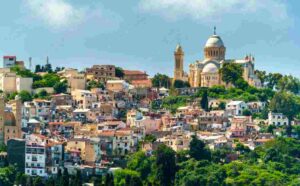
After our desert adventure, we returned to civilization and headed north to Algiers, Algeria’s vibrant capital city. A fusion of French colonial architecture, Ottoman influences, and modern high-rises, Algiers offers a captivating mix of old and new.
Once a popular destination for Victorian travelers, this capital has seen its tourism decline due to struggles for independence and civil war. However, with renewed stability, it’s emerging as an exciting alternative to Morocco for adventurous travelers. June offers pleasant weather in the high 20s Celsius (upper 70s Fahrenheit), making it a perfect time to explore the city and relax on the golden sands of Zéralda Beach, just a 30-minute trip away.
This capital is a captivating blend of architectural styles. Wide colonial boulevards lead to shaded medieval alleyways, while romantic Moorish mansions stand in contrast to the glittering minarets of Islamic mosques. A top destination is the Kasbah, a UNESCO World Heritage Site. This maze-like neighborhood, inhabited since 600 BC, offers a glimpse into the city’s rich history.
However, it is highly recommended that you only visit the Kasbah with a guide as even the locals think that the neighborhood can be dangerous for foreigners. There are plenty of English speaking guides at the many entrances to the Kasbah or you can arrange one through Fancy Yellow (listed below in our Guide/Driver recommendations).
Imagine the sound of songbirds echoing through the streets as you explore historic sites like the neo-Byzantine basilica of Notre-Dame d’Afrique and the Great Mosque of Algiers, one of the few remaining examples of Almoravid architecture.
Traditional artisans continue their crafts in crumbling stone cellars, offering unique souvenirs like hammered copperware and repaired jewelry. To delve deeper into Algeria’s past, visit the National Museum of Antiquities, which houses treasures like mosaics from the Roman city of Tipaza.
Mingle with locals as you stroll along the waterfront Boulevard Zighoud Youcef. Don’t miss the Grande Poste, a magnificent neo-Moorish post office that resembles a vanilla ice cream creation. Hop on the new metro for a five-stop journey to the Jardin d’Essai, a beautiful botanical garden overlooking the sparkling Mediterranean.
Finally, pay your respects at the Martyrs’ Memorial, a poignant reminder of those who fought for Algeria’s independence. The esplanade offers some of the best views in the city.
In the capital we stayed at the Hyatt Regency across from the airport. They were very kind to allow us, as Globalists, to check in very early and check out at 19:00, which made our flights within the country much easier. A Heetch ride to the capital was only a few dollars, making it a great location for us.
Djemila, Constantine, and Timgad: A Journey Through Roman Algeria
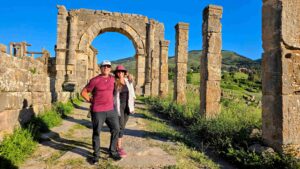
Djemila
Our journey continues eastward, taking us back in time to explore the grandeur of Roman Algeria. Djemila, also known as Cuicul, is a UNESCO World Heritage Site that boasts some of the best-preserved Roman ruins in North Africa. Marvel at the towering arches of the Caracalla Thermae, a bath complex, and wander through the grand Forum, the heart of the ancient city.
Don’t miss the Djemila Museum before exploring the ruins themselves. This museum houses many treasures unearthed from the site, but the real star of the show is the incredible collection of mosaics. Covering a staggering 1700 square meters and adorning both the floors and walls, these mosaics are some of the finest ever discovered in North Africa. Prepare to be amazed by their intricate details and vibrant colors!
Fancy Yellow (see information below in the Guide/Driver section) drove us from the capital’s airport to Djemilla. We were greeted by an English speaking guide and taken around the Roman Ruins for about 3 hours. The driver then took us to Constantine. The price of this tour and transfers was $200 USD for both of us.
Constantine
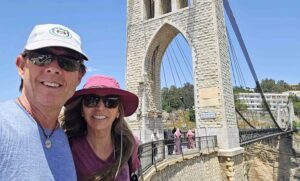
Next, we travel to Constantine, a city dramatically perched on a rocky plateau overlooking the Rhumel Gorge. This ancient city, nicknamed the “City of Bridges” due to the engineering marvels that connect its different neighborhoods, boasts a rich history dating back to the Phoenicians. Explore the well-preserved Great Mosque and the Kasbah, the old city center.
Constantine’s bridge-building history goes back to a ruined Roman aqueduct and remnants of even older bridges built upon the natural arch. Today, Constantine has eight bridges serving the city.

Two of the most important bridges are celebrating their 115th anniversary this year. The Sidi M’Cid Bridge, a hybrid suspension and cable-stayed design by French engineer Ferdinand Arnodin, was once the world’s highest at 164 meters long and 175 meters above the gorge. The other bridge celebrating an anniversary is the Sidi Rached Bridge, a contrasting design featuring 27 stone arches designed by Paul Séjourné and Georges Boisnier.
Another notable bridge is the El Kantara Bridge, a modern update on a much older Roman-style bridge. The newest and longest bridge is the Trans-Rhumel Viaduct (Salah Bey Bridge), a cable-stayed marvel with a main span of 756 meters, inaugurated in 2014.
Constantine’s bridges showcase the city’s evolution and its commitment to innovation. These engineering feats, built upon centuries of history, serve as a symbol of the city’s vitality and identity.
Here we stayed at the Constantine Marriott, which was a short Heetch ride from most of the attractions and from Timgad. However, I have mixed feelings about this 5 star hotel. Unfortunately, I got food poisoning from the breakfast buffet here and ended up very sick for a prolonged period of time. After observing how the Chef was handling the food (with his bare hands), it was clear that food safety and hygiene were lacking.
Timgad
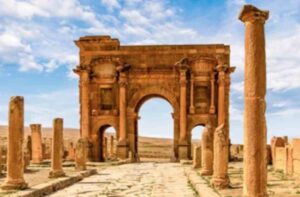
After spending a few days in Constantine venture an hour south to Timgad, which is an archaeological marvel offering a glimpse into the life of a Roman colony. Walk along the ancient Decumanus Maximus, the main street, and admire the impressive ruins of the forum, the theater, and the baths. Imagine gladiatorial contests unfolding in the well-preserved amphitheater, a testament to the grandeur of this once-thriving Roman city.
Timgad, shows off some of the most impressive Roman ruins in North Africa. This sprawling ancient city is remarkably well-preserved, and in 1982, UNESCO recognized its significance by adding it to the World Heritage List. Exploring Timgad is like stepping back in time and wandering through the streets of a bygone era.
Ghardaia: A UNESCO Gem
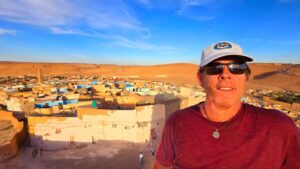
Ghardaia is an oasis city found among palm trees in Algeria’s northern M’zab Valley. This ancient city, founded in the 11th century by the Mzabite Berbers, is one of five unique settlements that make up a UNESCO World Heritage Site. These fortified towns, including Ghardaia, Melika, Beni Isguen, Bou Noura, and Bounouara, showcase a remarkable style of pre-Saharan architecture, perfectly adapted to the desert climate.
Imagine towering mudbrick buildings called ksour, used for storing grain, and narrow streets that provide shade from the scorching sun. This unique design, along with a clever irrigation system called foggara, highlights the Mzabite people’s resourcefulness in this harsh environment. However, Ghardaia is also known for its strong social codes and conservative way of life. Visitors here will encounter a world quite different from modern Algerian cities.
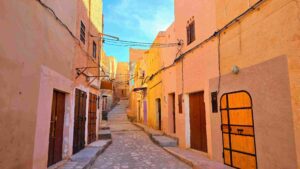
Taking pictures of local people is strictly forbidden. Women are often seen dressed in a white haik, a full-body veil that reveals only one eye if they are married. These traditions are an important part of Ghardaia’s identity and reflect the strong Islamic faith of the Mzabite community. Exploring Ghardaia feels like stepping back in time, a place where ancient ways of life are still cherished.
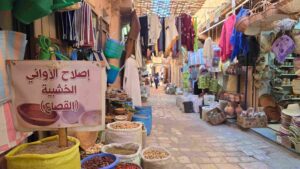
Each of the five M’zab Valley cities has its own charm. Melika, the smallest, is known for its beautiful palm groves and reddish-brown buildings. Beni Isguen, considered the most conservative, boasts a well-preserved old town and a lively market. Bou Noura is famous for its carpet-weaving tradition, and Bounouara is known for its Friday mosque, the oldest in the M’zab Valley. Exploring all five cities offers a captivating journey into the rich history and cultural heritage of the Mzabite Berbers.
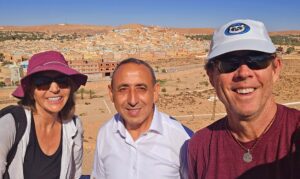
Mounir provided different options for our accommodations, but we chose to stay at the Belvedere, overlooking the Mzab Valley. If you have a chance, consider staying at one of the guest houses that he had showed us – they were incredible!
Tipaza and Cherchell

Tipaza and the Tipasa Roman Ruins
After returning to Algiers, we did a day trip to the charming coastal town of Tipaza. Here, the Tipasa Roman ruins mingle with beautiful beaches, creating a unique atmosphere. Explore the Roman theater and the haunting necropolis, an ancient cemetery offering a glimpse into Roman funerary practices.
Unfortunately, much of Tipasa’s ruins are just that – ruins strewn about haphazardly along with some garbage. However, with a little imagination, seeing the shimmering Mediterranean Sea along with some of the pieces of history under the shining sun we could imagine the glory Tipasa in it’s prime.
Cherchell
A short drive away lies Cherchell, another Roman town where the ancient treasures have been collected in a museum. Cherchell’s true treasures lie in its history. Built on the site of the ancient city “Caesarea,” it was once a major attraction for sailors in the Mediterranean.
A visit to Cherchell is like a journey through time. The public square overlooking the harbor features beautiful trees and offers a glimpse of the city’s life. As you explore, keep an eye out for the impressive ruins of ancient aqueducts.
Start your exploration at the archaeological museum in “Martyrs’ Square.” This museum houses a rich collection of statues, mosaics, and funerary tombs, providing a window into Cherchell’s past. Next, head to the El Rahman mosque, with its unique architecture that echoes an ancient temple. Continue south through the charming alleyways to discover the grand theater and the forum, the heart of the Roman city. Finally, end your visit at the Great West Baths, another testament to Cherchell’s glorious past.
Logistics- Planning Your Algerian Adventure
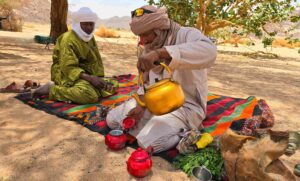
While Algeria is becoming increasingly accessible, some pre-trip planning is essential. The new Visa on Arrival system simplifies the process, but researching visa requirements and documentation is crucial. Depending on your itinerary, consider hiring a local guide, especially for navigating the desert regions.
The best time to visit Algeria depends on your preferences. Spring and autumn offer pleasant temperatures, while summer can be scorching, especially in the Sahara. The winter months can be mild along the coast but get colder in the mountains. Be sure to pack for the climate you’ll encounter and remember that modest clothing is recommended, especially in more conservative areas.
Algeria awaits the adventurous traveler seeking an unforgettable experience. From the majestic Sahara Desert to the captivating Roman ruins and the rich Berber culture, this North African nation promises an adventure unlike any other. So, pack your bags, embrace the unexpected, and embark on a journey to discover the magic of Algeria!
SAFETY

Algeria is a country that has a lot of military, check points and police oversight. When we landed in Ghardaia, all tourists were accompanied not only by their guides, but also by police vehicles to our hotels. Even with so much oversight, we felt very safe. However, prior to embarking on this type of adventure, it is crucial to be aware of the potential risks.
When we visited and at the time of writing, all travel advisories (Canada, USA, Australia, etc.,) where at the highest level – Do Not Travel. This is due to the potential risk of terrorism and kidnapping in this country. We were aware of this and made a conscious decision based on the information that we had from our guide, trusted news channels and our tolerance for risk.
I mean hey, we have visited the DRC, Burkina Faso, Central African Republic of the Congo, Afghanistan, Myanmar, Sudan, South Sudan and some other risky places. All of these quests were based on deep research, conversations with people on the ground balanced with our sense for adventure.
Ultimately, the decision to travel here (or to any other potentially risky travel destination) rests with you and your personal tolerance for risk.
CURRENCY

This country uses the Algerian Dinar as currency, however, the USD or Euro is the currency that most people want to receive. The official exchange rate is a fraction of the one you can get from the black Market exchange people who are visible at the airport and other parts of the city. I was able to negotiate an exchange of 100 euros to 230 Dinar in Algiers.
PRO TIP: Do your exchange in Algiers prior to traveling to smaller cities like Ghardaia and Djanet as the exchange there is not as good.
TOURIST VISA
Traveling to Algeria just got easier with the new Visa on Arrival program! While there are still some regulations and paperwork to navigate, it’s definitely simpler than the old process. You will need a local sponsor, and luckily your guide can act in that role. For us, it took almost a month to receive the fully stamped visa. Our guide was instrumental in shepherding the visa application procedure.
CONNECTIVITY: SIM/ESIM CARDS
SIM cards can be purchased in many places in the capital, but since you will most likely need a ride share upon arrival, we highly recommend purchasing a SIM card at the airport. In the Algiers airport the kiosks for Ooredoo and Mobilis are located on the first floor.
We purchased the Mobilis SIM with 50 Gb of data for $7.50 USD. It worked well in some places, but was spotty at best in the majority of the country. Others have said similar things about the Ooredoo SIM card. Therefore if there are a few of you in a group, we would recommend buying one of each SIM card and hot-spotting each other when one card is working better than the other.
PRO TIP: Connectivity in the National Parks near Djanet have no connectivity whatsoever. Our guide carried a satellite phone in case of an emergency. Had we asked him in advance, he would have brought his other satellite phone which can hot spot for emergency emails and messages. Therefore, if you absolutely need to be connected during your stay in the desert, ask your guide to provide that service.
ALGERIA GUIDE/DRIVER
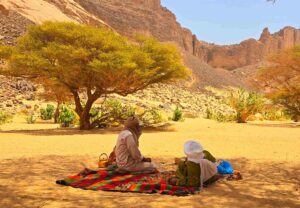
We were very fortunate to spend time with some of the most professional and personable guides during our stay in this country. Abdellah and Mounir set a new bar for guides in our opinion. They made our adventures spectacular and we cannot recommend them enough!
Fancy Yellow did a good job of transporting us and getting us to some of the more difficult areas (Djemila for instance) that were tricky if not impossible to do on our own. Below are the guides that we can highly recommend:
Djanet Area and the Desert National Parks: Abdellah Elies, www.ihakettravels.com, [email protected] + 213 666 14 51 83
Ghardaia: Mounir Fartas, +213 555 43 14 30
Djemila: Fancy Yellow Travel Services, Omar Zahafi, +213 542 84 06 82
TRANSPORTATION

It is quite easy to figure out transportation, once you are in Algeria. We were able to purchase flights within the country on Air Algeria very inexpensively and easily at the airport. Our wonderful guide Abdellah, purchased our tickets from Algiers to Ghardaia prior to our arrival. These tickets do go quickly, so we recommend pre-planning with your guide in advance to ensure that you arrive at your tour on time.
There are convenient train lines in Algeria as well. However, the website only works once you are in country and tickets can be purchased same day.
For the bus system, you can access it through this website. The buses vary in quality, with most of them being quite tired.
For ride shares, Heetch is the best option and is available for Android or Apple.
PRO TIP: Make sure to exchange your foreign currency on the black-market prior to purchasing your tickets, to get the best deal.
Wrap Up
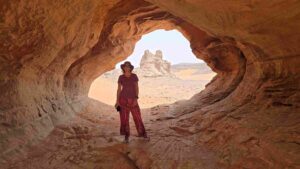
Wow! Algeria really impressed us, and in the 11 days here, we only scratched the surface of all there is to see and do in this huge and extremely diverse country. The southern Sahara area of Red Tadrart was definitely a highlight. In addition, the Roman ruins of Djemila and the beauty of Constantine are not to be missed.
Furthermore, Ghardaia provided such an interesting glimpse into a world from another time that exists today as it did hundreds of years ago.
Although this was our first time in this country, it is definitely not the last. We would love to return and visit the west and other parts of the southern desert. What about you – have you been to North Africa? What was your favorite part or where would you like to visit? Let us know in the comments.


1 Comment